
ab66705 staining PAI1 in MCF-7 cells treated with splitomicin (ab141120), by ICC/IF. Increase in PAI1 expression correlates with increased concentration of splitomicin, as described in literature.The cells were incubated at 37°C for 48 hours in media containing different concentrations of ab141120 (splitomicin) in DMSO, fixed with 100% methanol for 5 minutes at -20°C and blocked with PBS containing 10% goat serum, 0.3 M glycine, 1% BSA and 0.1% tween for 2h at room temperature. Staining of the treated cells with ab66705 (1 μg/ml) was performed overnight at 4°C in PBS containing 1% BSA and 0.1% tween. A DyLight 488 anti-rabbit polyclonal antibody (ab96899) at 1/250 dilution was used as the secondary antibody. Nuclei were counterstained with DAPI and are shown in blue

IHC image of PAI1 staining in Human normal kidney formalin fixed paraffin embedded tissue section, performed on a Leica Bond™ system using the standard protocol F. The section was pre-treated using heat mediated antigen retrieval with sodium citrate buffer (pH6, epitope retrieval solution 1) for 20 mins. The section was then incubated with ab66705, 5µg/ml, for 15 mins at room temperature and detected using an HRP conjugated compact polymer system. DAB was used as the chromogen. The section was then counterstained with haematoxylin and mounted with DPX. For other IHC staining systems (automated and non-automated) customers should optimize variable parameters such as antigen retrieval conditions, primary antibody concentration and antibody incubation times.

ICC/IF image of ab66705 stained HepG2 cells. The cells were 4% PFA fixed (10 min) and then incubated in 1%BSA / 10% normal Goat serum / 0.3M glycine in 0.1% PBS-Tween for 1h to permeabilise the cells and block non-specific protein-protein interactions. The cells were then incubated with the antibody (ab66705, 1µg/ml) overnight at +4°C. The secondary antibody (green) was Alexa Fluor® 488 Goat anti-Rabbit IgG (H+L) used at a 1/1000 dilution for 1h. Alexa Fluor® 594 WGA was used to label plasma membranes (red) at a 1/200 dilution for 1h. DAPI was used to stain the cell nuclei (blue). This antibody also gave a positive result in 100% Methanol fixed (5 min) HepG2 cells at 5µg/ml.
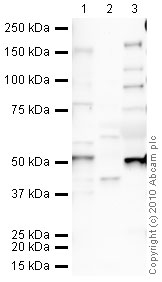
All lanes : Anti-PAI1 antibody (ab66705) at 1 µg/mlLane 1 : Liver (Human) Tissue Lysate - adult normal tissue (ab29889)Lane 2 : Lung (Human) Tissue LysateLane 3 : Human Plasma Total Protein Lysate Lysates/proteins at 10 µg per lane.SecondaryGoat polyclonal to Rabbit IgG - H&L - Pre-Adsorbed (HRP) at 1/3000 dilutionPerformed under reducing conditions.
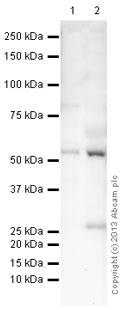
All lanes : Anti-PAI1 antibody (ab66705) at 1 µg/mlLane 1 : Liver (Human) Tissue Lysate - adult normal tissue (ab29889)Lane 2 : Human Plasma Total Protein Lysate (ab83997)Lysates/proteins at 10 µg per lane.SecondaryGoat Anti-Rabbit IgG H&L (HRP) (ab97051) at 1/10000 dilutiondeveloped using the ECL techniquePerformed under reducing conditions.

ab66705 staining PAI1 in HeLa cells treated with dynasore (ab120192), by ICC/IF. Increase in PAI1 expression correlates with increased concentration of dynasore, as described in literature.The cells were incubated at 37°C for 6h in media containing different concentrations of ab120192 (dynasore) in DMSO, fixed with 100% methanol for 5 minutes at -20°C and blocked with PBS containing 10% goat serum, 0.3 M glycine, 1% BSA and 0.1% tween for 2h at room temperature. Staining of the treated cells with ab66705 (5 µg/ml) was performed overnight at 4°C in PBS containing 1% BSA and 0.1% tween. A DyLight 488 goat anti-rabbit polyclonal antibody (ab96899) at 1/250 dilution was used as the secondary antibody. Nuclei were counterstained with DAPI and are shown in blue.
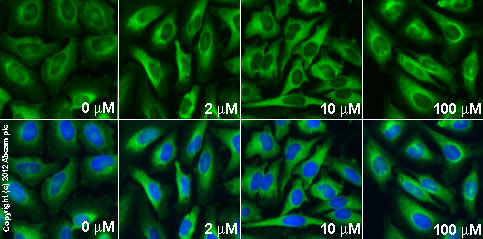
ab66705 staining PAI1 in HeLa cells treated with Dyngo-4a™ (ab120689), by ICC/IF. Increase in PAI1 expression correlates with increased concentration of Dyngo-4a™, as described in literature.The cells were incubated at 37°C for 6h in media containing different concentrations of ab120689 (Dyngo-4a™) in DMSO, fixed with 100% methanol for 5 minutes at -20°C and blocked with PBS containing 10% goat serum, 0.3 M glycine, 1% BSA and 0.1% tween for 2h at room temperature. Staining of the treated cells with ab66705 (5 µg/ml) was performed overnight at 4°C in PBS containing 1% BSA and 0.1% tween. A DyLight 488 goat anti-rabbit polyclonal antibody (ab96899) at 1/250 dilution was used as the secondary antibody. Nuclei were counterstained with DAPI and are shown in blue.

ab66705 staining PAI1 in HeLa cells treated with dynole-34-2™ (ab120463), by ICC/IF. Increase in PAI1 expression correlates with increased concentration of dynole-34-2™, as described in literature.The cells were incubated at 37°C for 24h in media containing different concentrations of ab120463 (dynole-34-2™) in DMSO, fixed with 100% methanol for 5 minutes at -20°C and blocked with PBS containing 10% goat serum, 0.3 M glycine, 1% BSA and 0.1% tween for 2h at room temperature. Staining of the treated cells with ab66705 (5 µg/ml) was performed overnight at 4°C in PBS containing 1% BSA and 0.1% tween. A DyLight 488 goat anti-rabbit polyclonal antibody (ab96899) at 1/250 dilution was used as the secondary antibody. Nuclei were counterstained with DAPI and are shown in blue.
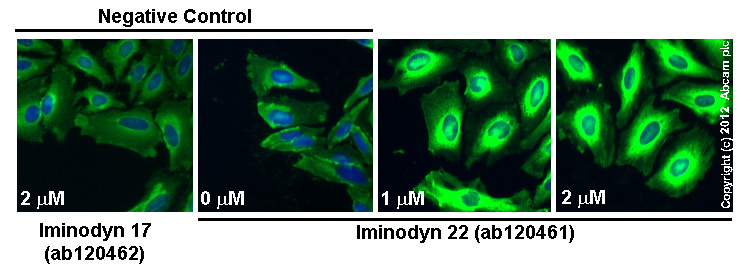
ab66705 staining PAI1 in HeLa cells treated with iminodyn-22™ (ab120461), by ICC/IF. Increase in PAI1 expression correlates with increased concentration of iminodyn-22™, as described in literature.The cells were incubated at 37°C for 48h in media containing different concentrations of ab120461 (iminodyn-22™) in DMSO, fixed with 100% methanol for 5 minutes at -20°C and blocked with PBS containing 10% goat serum, 0.3 M glycine, 1% BSA and 0.1% tween for 2h at room temperature. Staining of the treated cells with ab66705 (5 µg/ml) was performed overnight at 4°C in PBS containing 1% BSA and 0.1% tween. A DyLight 488 goat anti-rabbit polyclonal antibody (ab96899) at 1/250 dilution was used as the secondary antibody. Nuclei were counterstained with DAPI and are shown in blue.

ab66705 staining PAI1 in HeLa cells treated with iminodyn-17™ (ab120462), by ICC/IF. Increase in PAI1 expression correlates with increased concentration of iminodyn-17™, as described in literature.The cells were incubated at 37°C for 48h in media containing different concentrations of ab120462 (iminodyn-17™) in DMSO, fixed with 100% methanol for 5 minutes at -20°C and blocked with PBS containing 10% goat serum, 0.3 M glycine, 1% BSA and 0.1% tween for 2h at room temperature. Staining of the treated cells with ab66705 (5 µg/ml) was performed overnight at 4°C in PBS containing 1% BSA and 0.1% tween. A DyLight 488 goat anti-rabbit polyclonal antibody (ab96899) at 1/250 dilution was used as the secondary antibody. Nuclei were counterstained with DAPI and are shown in blue.

ab66705 staining PAI1 in HeLa cells treated with MiTMAB™ (ab120466), by ICC/IF. Increase in PAI1 expression correlates with increased concentration of MiTMAB™, as described in literature.The cells were incubated at 37°C for 24h in media containing different concentrations of ab120466 (MiTMAB™) in DMSO, fixed with 100% methanol for 5 minutes at -20°C and blocked with PBS containing 10% goat serum, 0.3 M glycine, 1% BSA and 0.1% tween for 2h at room temperature. Staining of the treated cells with ab66705 (5 µg/ml) was performed overnight at 4°C in PBS containing 1% BSA and 0.1% tween. A DyLight 488 goat anti-rabbit polyclonal antibody (ab96899) at 1/250 dilution was used as the secondary antibody. Nuclei were counterstained with DAPI and are shown in blue.

ab66705 staining PAI1 in HeLa cells treated with OcTMAB™ (ab120467), by ICC/IF. Increase in PAI1 expression correlates with increased concentration of OcTMAB™, as described in literature.The cells were incubated at 37°C for 24h in media containing different concentrations of ab120467 (OcTMAB™) in DMSO, fixed with 100% methanol for 5 minutes at -20°C and blocked with PBS containing 10% goat serum, 0.3 M glycine, 1% BSA and 0.1% tween for 2h at room temperature. Staining of the treated cells with ab66705 (5 µg/ml) was performed overnight at 4°C in PBS containing 1% BSA and 0.1% tween. A DyLight 488 goat anti-rabbit polyclonal antibody (ab96899) at 1/250 dilution was used as the secondary antibody. Nuclei were counterstained with DAPI and are shown in blue.
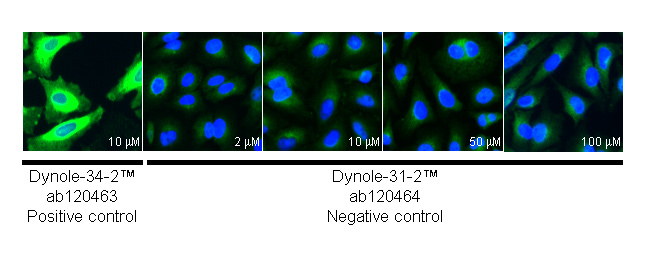
ab66705 staining PAI1 in HeLa cells treated with dynole-31-2™ (ab120464), by ICC/IF. No change in PAI1 expression with increased concentration of dynole-31-2™ (negative control for dynole 34-2™ (ab120463), as described in literature.The cells were incubated at 37°C for 6h in media containing different concentrations of (ab120464 (dynole-31-2™) in DMSO, fixed with 100% methanol for 5 minutes at -20°C and blocked with PBS containing 10% goat serum, 0.3 M glycine, 1% BSA and 0.1% tween for 2h at room temperature. Staining of the treated cells with ab66705 (5 µg/ml) was performed overnight at 4°C in PBS containing 1% BSA and 0.1% tween. A DyLight 488 goat anti-rabbit polyclonal antibody (ab96899) at 1/250 dilution was used as the secondary antibody. Nuclei were counterstained with DAPI and are shown in blue.

ab66705 staining PAI1 in HepG2 cells treated with BAPTA sodium salt (ab120449), by ICC/IF. Increase in PAI1 expression correlates with increased concentration of BAPTA sodium salt, as described in literature.The cells were incubated at 37°C for 4 hours in media containing different concentrations of ab120449 (BAPTA sodium salt) in DMSO, fixed with 100% methanol for 5 minutes at -20°C and blocked with PBS containing 10% goat serum, 0.3 M glycine, 1% BSA and 0.1% tween for 2h at room temperature. Staining of the treated cells with ab66705 (5 µg/ml) was performed overnight at 4°C in PBS containing 1% BSA and 0.1% tween. A DyLight 488 goat anti-rabbit polyclonal antibody (ab96899) at 1/250 dilution was used as the secondary antibody. Nuclei were counterstained with DAPI and are shown in blue.

ab66705 staining PAI1 in HepG2 cells treated with BAPTA-AM (ab120503), by ICC/IF. Increase in PAI1 expression correlates with increased concentration of BAPTA-AM, as described in literature.The cells were incubated at 37°C for 4 hours in media containing different concentrations of ab120503 (BAPTA-AM) in DMSO, fixed with 100% methanol for 5 minutes at -20°C and blocked with PBS containing 10% goat serum, 0.3 M glycine, 1% BSA and 0.1% tween for 2h at room temperature. Staining of the treated cells with ab66705 (5 µg/ml) was performed overnight at 4°C in PBS containing 1% BSA and 0.1% tween. A DyLight 488 goat anti-rabbit polyclonal antibody (ab96899) at 1/250 dilution was used as the secondary antibody. Nuclei were counterstained with DAPI and are shown in blue.














